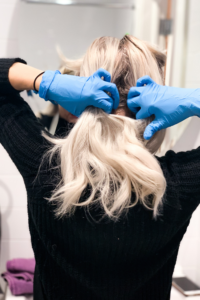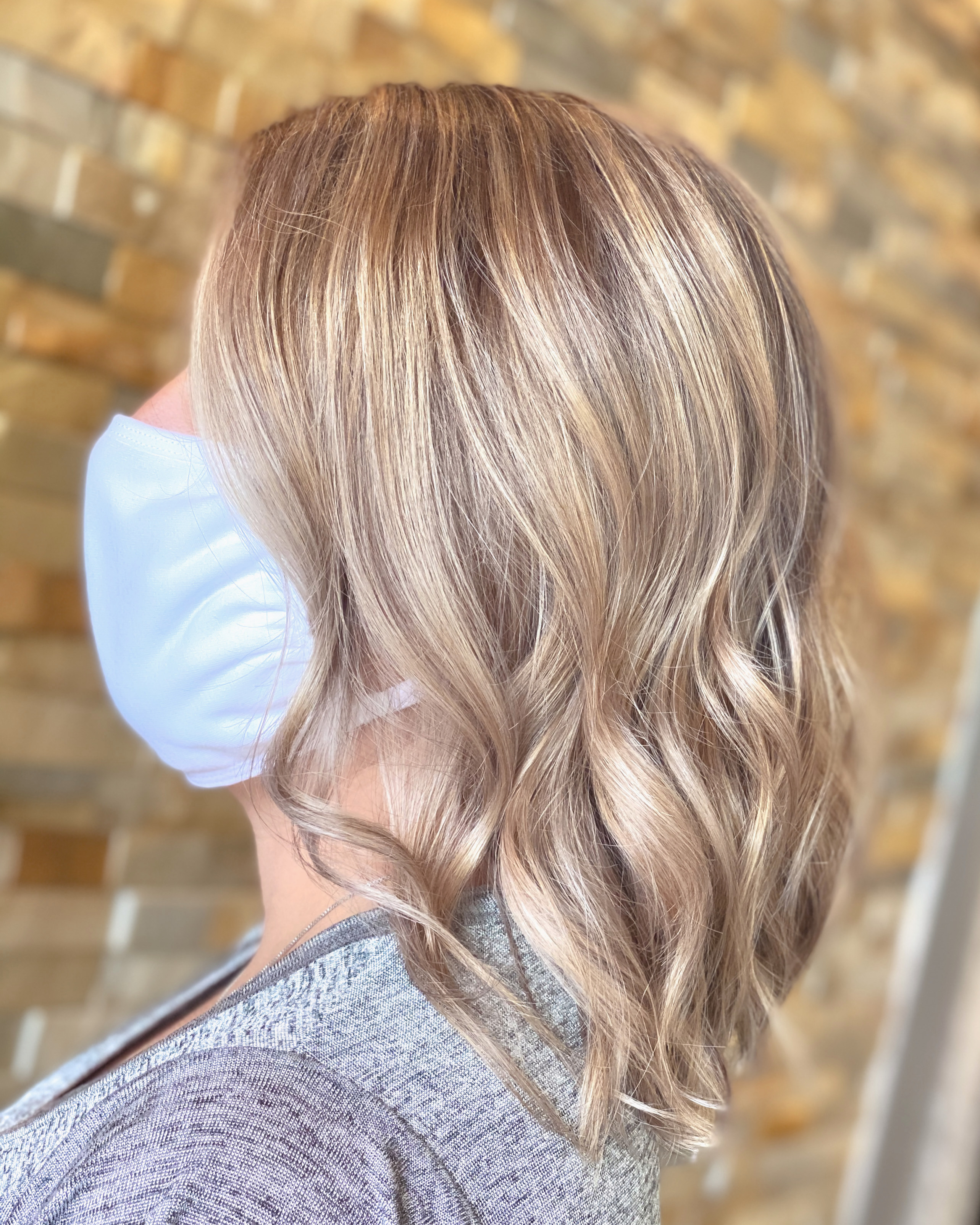Is Platinum Blonde Really Achievable For Me?
In this post I’m going to cover whether platinum blonde hair is actually achievable for everyone. I’ll discuss who it’s a good fit for, as well as who should consider other options.
To learn about the best tips for maintaining platinum blonde and bleached hair, see my post here.

How we dye hair platinum blonde
Before discussing if this is an option for you, first you need to understand how we get hair to a platinum blonde color.
To do this, ALL pigment in the hair needs to be removed. This means we are lightening the hair to the highest degree, also known as level 10. This can be done only with bleach. Some other words for this process are: stripping, bleaching, lightening, and decolorizing.
Depending on what level your hair is to begin with will determine how hard of a process this is. If your hair is a level 1, also known as black, then this can be extremely challenging. Especially if your hair has been previously colored.
Oftentimes this process can take multiple sessions. No matter if you have the best hair stylist in the world, sometimes it is just not physically possible to get the hair safely to a platinum blonde color in one go.
Now, once all pigment from the hair has been removed and it is to a level 10, we can then deposit a toner. The toner is what determines the shade of the hair color. Typically for platinum blonde, an ashy or cool toner is applied.
To learn more about the level system in hair color, see my post here. And to learn more about toning the hair to the desired shade, see my post here.
Platinum blonde hair isn’t safely achievable for everyone
This pill may be hard to swallow for some, but unfortunately platinum blonde hair just isn’t safely possible for some clients. Sure, maybe we can get your hair light enough, but it won’t come without a cost. Oftentimes the hair can’t handle the bleaching process needed to get it light enough, and the hair can turn to mush and break off.
There are 4 main factors to consider when determining if you’re a good candidate for platinum blonde hair:
1. The condition of your hair
First, we must consider the condition of your hair. If your hair is damaged and breaking off, it doesn’t matter if the color is where you want it. The condition of your hair should always be your number 1 priority.
Before the hair is bleached, it should be in good condition to begin with. This means no excessive split ends traveling up the hair strand, and the elasticity and porosity of the hair are maintained. If your hair is already damaged, I wouldn’t go through with the service.
To better understand what condition your hair currently is in, see my post here.
2. Your current hair color
Next, we need to consider your current hair color. As we briefly mentioned earlier, the darker your hair is the more of a challenge this becomes.
It is also an extremely important distinction if your hair is virgin or previously colored. If your hair has been previously colored with permanent hair color, this makes the process that much more difficult.
Permanent hair color permanently alters your hair composition. The color is locked into the cortex (middle layer) of your hair even if the color has appeared to fade. The hair has still been altered and it won’t go back to being virgin again until it grows out and has been cut off.
During the bleaching process, it is much more difficult to remove colored pigment from hair than it is to remove natural pigment. This is often what can make or break your journey of becoming a platinum blonde.
You’ll need to consider the condition of your hair and determine if it can handle the amount of bleaching necessary based on your current color situation. Oftentimes it will take a number of sessions to safely lighten your hair to a platinum blonde color.
To learn more about permanent, demi-permanent, and semi-permanent hair color, see my post here.
3. What’s your budget?
Now that we’ve discussed some of the challenges you may face, it’s time to talk money. Understand that platinum blonde is the most expensive hair color. Not only is it expensive to get to, but it’s also expensive to maintain.
If your hair is in poor condition AND it’s been colored dark, not only will this be damaging, but it will be expensive. Blonding services are often considered corrective color services because of how complicated they are. We oftentimes need to use a different mixture and strength of bleach for different sections of your hair to get the color even.
Corrective color services usually run a minimum of $100 per hour and go up from there based on the experience of the stylist, the products used, and the location of the salon. These services usually take a minimum of 3-6 hours, but I have spent 10 hours on a client before.
Understand that your starting hair color level and whether it is virgin hair or not will make a huge difference in this cost. If you are on a tight budget, I wouldn’t recommend opting for platinum blonde.
4. Maintenance needs
Platinum blonde is hands down the highest maintenance hair color of them all. This is for a number of reasons.
For one, you typically need to come into the salon often for touch-ups depending on what technique you have. If you’re a scalp to ends blonde, you need to come in every 4 weeks to have your roots done. If you wait longer than 6 weeks, this service changes from a root touch-up to a corrective color service to avoid banding in the hair.
But if you wear a more lived in platinum blonde that doesn’t require as frequent of a root service, you may still need to come in for toner applications in-between your blonding service. This is to maintain the platinum tone that fades with every wash.
And aside from the frequent salon visits, you have a lot of at home maintenance to keep up with. Since your hair has been bleached, you need to take extra care of it to ensure the integrity of your hair. for example, I recommend to use a deep conditioning treatment every time you wash your hair if it’s been bleached.
Here are some considerations:
- Purple shampoo & conditioner
- Regular deep conditioning & bonding treatments
- Leave in conditioner & serum
- Wash your hair only once a week in cool (not hot!) water
- Avoid using heat tools too often (low heat when you do)
- Cover your hair from the sun & tanning beds
- Don’t get your hair wet in the pool or ocean
- No large bath towel turbans
- Extra caution when brushing especially when wet
- No messy buns; loose braids and low pony tails only
- Silk pillow case only
For my full guide on maintaining blonde and bleached hair, see my post here.
Product recommendations for platinum blonde hair
***Since I’m sharing the products that I love to use with you guys, my posts may include affiliate links to these products. If you take action and purchase a product through clicking one of my links, I’ll make some commission money from it at no extra cost to you. This enables me to be able to continue giving you awesome hair tips, so thanks! ***
Olaplex is my number one recommendation for brands when it comes to platinum blonde hair. The company has patented technology that repairs broken bonds in the hair from the bleaching process.
- Olaplex no. 4P – Purple toning shampoo to remove yellow tones with bonding technology
- Olaplex no. 5p – Purple toning conditioner to remove yellow tones with bonding technology
- Olaplex no. 3 – Strengthening bonding treatment (alternate with no. 8 each time you wash)
- Olaplex no. 8 – Moisture treatment to hydrate the hair (alternate with no. 3 each time you wash)
- Olaplex no. 6 – Leave in conditioner to replenish lost moisture and reduce frizz
- Olaplex no. 9 – Leave in serum to protect hair from heat tools and soften
- Olaplex no. 4D – Dry shampoo to help you extend time between washes
Other options aside from platinum blonde
So if you’ve decided that platinum blonde just isn’t for you after reading this far, fret not. I have a few other options for you to choose from that are less damaging, less expensive, and lower maintentance.
1. Traditional highlights

Traditional highlights are a great alternative to a full platinum blonde technique. These can be done in many different variations based on your hair condition, color, budget, and maintenance needs. Typically you’ll leave some of your natural color throughout your hair when you choose this option.
I don’t normally recommend low lights (darker highlights) when you are a fan of a platinum blonde color. This is because low lights tend to fade warm, and it can also become more difficult to lighten those low lights over time as your hair grows out.
Best for: If you still want to be bright blonde, or if you don’t enjoy a “rooty” look.
2. Lived-in hair color

Lived-in hair color is typically more “rooty” than traditional highlights. This means you may have a bit of a root to begin with when you leave the salon. We do this for a much more seamless grow-out than traditional highlights will give.
These services can be done with foils or with open air balayage techniques. Lived-in hair color may be a little more expensive than traditional highlights, but it will last you longer between visits.
Best for: If you’re looking for lowest maintenance and don’t mind having a bit of your natural color showing, particularly near your roots.
3. Warm or neutral blonde shades

Depending on your situation, it may be best to opt for a neutral or a warmer blonde tone instead. This doesn’t always have to be permanent, but it may be a good option until your hair is healthy enough to get to a platinum blonde color.
I have had a few clients with a natural level 3 or lower not be able to safely get to a platinum blonde shade. I tried, but it just wasn’t possible without damaging their hair. We opted for a neutral blonde color instead, and this actually worked with their skin tone better anyway.
To learn about what hair color shades will work with your skin tone, see my post here.
Best for: If your hair can’t safely get to a platinum shade, typically those with dark hair.
Conclusion
Unfortunately, platinum blonde hair isn’t safely achievable for everyone. This is because in order to dye your hair to a platinum shade, all pigment must be removed from the hair. This is done by bleaching. If your hair is dark, damaged, or previously colored, you may not be a good candidate for platinum blonde hair.
Before attempting to dye your hair platinum blonde, you must consider:
- The current condition of your hair
- The current color of your hair & if it is virgin or chemically altered
- Your budget
- Your maintenance needs; both in salon visits and at home care
There are several alternative options to platinum blonde hair:
- Traditional highlights
- Lived-in hair color
- Warm or neutral blonde shades
If you have any further questions regarding going platinum blonde, leave them for me in the comments! As always, Have A Good Hair Day!


